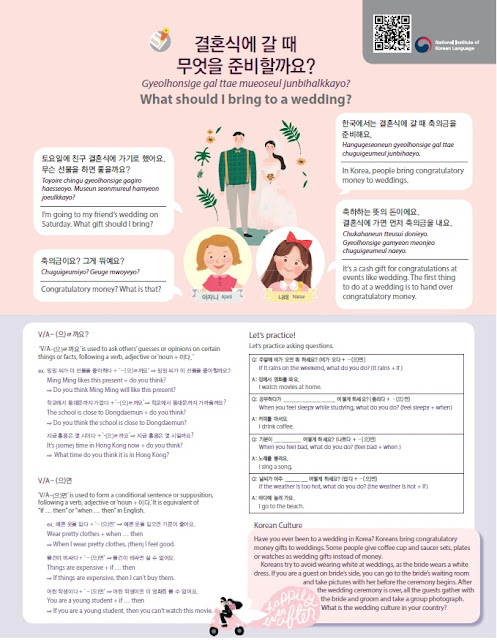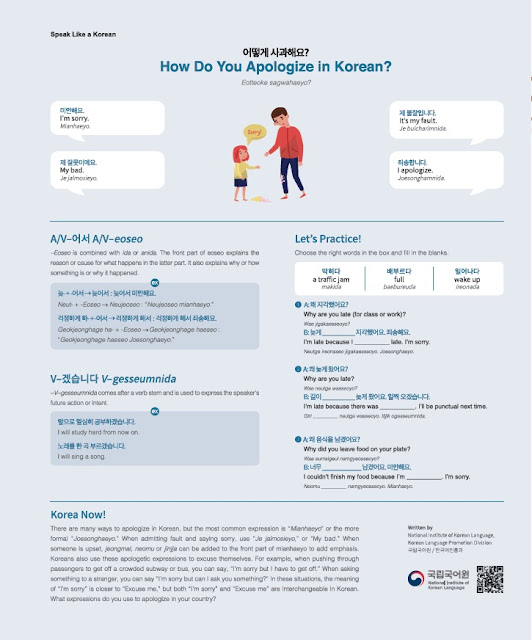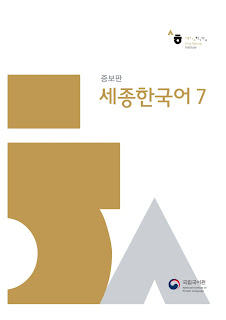Learning Korean Lessons PDF eBook is a set of 56 lessons published monthly on The National Institute of The Korean Language during the period of 2016 - 2020.
Each lesson is structured with a conversation, grammar, practice, and culture explain.
These lessons are free to access and download from Center for Teaching and Studying Korean (한국어교수학습샘터).
You can download the ebook here:
Learning Korean Lessons PDF eBook by KCenter
Book contents:
1. 새해 복 많이 받으세요 | Happy new year
2. 한국어로 숙제하기가 힘들지요? | Doing your homework in Korean in hard, isn't it?
3. 저는 영화 보는 것을 좋아해요. | I like watching movies.
4. 이번 제 생일에는 집에서 파티를 할까 해요. | I am thinking of throwing a birthday party at my home.
5. 박물관에서는 사진을 찍으면 안 돼요. | Taking photos is prohibited in the museum.
6. 날씨와 계절 | Weather and seasons
7. 한국에 오기 전에 태권도를 배웠어요? | Did you practice taekwondo before coming to Korea?
8. 한국의 명절 -추석| Korean Holidays - Chuseok
9. 한국어를 적는 글, 한글 | Hangeul: The Korean Alphabet
10. 한국에 온 지 일 년 되었어요. | It's been a year since I came to Korea
11. 가족이 몇 명이에요? | How many people are in your family?
12. 창문이 크거나 방이 밝았으면 좋겠어요. | I like bigger window or a brighter room.
13. 김 선생님 계세요? | Excuse me, is Mr. Kim in?
14. 올해 무엇을 결심했어요? | What have you decided to do this year?
15. 어떤 습관을 가지고 있어요? | What are your habits?
16. 친구 집에 갈 때 뭘 가지고 가면 좋아요? | What should I bring to my friend's house?
17. 여행 춘비는 잘 하고 있어요? | Are you ready for your upcoming trip?
18. 한국의 문화와 여려분 나라의 문화는 어떻게 달라요? | How is your culture different from Korean culture?
19. 한국에서는 더울 때 어떤 음식을 먹는지 아세요? | Do you know what Koreans like to eat on hot summer days?
20. 결혼식에 갈 때 무엇을 준비할까요? | What should I bring to a wedding?
21. 한국에서는 추석 연휴를 어떻게 보내는지 아세요? | Do you know how people spend the Chuseok holiday in Korea?
22. 한국에서 어디에 가 본 적이 있어요? | Where have you been in Korea?
23. 시험 보는 친구에게 무엇을 선물하는 것이 좋아요? | What should I give a friend who is going to take an exam?
24. 2월에 평창으로 갈까요? | Shall we visit Pyeongchang in February?
25. 새해 복 많이 받으세요 | May you receive a lot of luck in the new year
26. 벚꽃 축제에 가다면서요? | I heard you were going to the cherry blossom festival
27. 한국의 전통 시장에 가 보셨어요? | Have you been to Korea's traditional markets?
28. 한국의 민속놀이를 해 보셨어요? | Have you played traditional Korean folk games before?
29. 한옥 마을에 가본 적이 있어요? | Have you been to a Hanok village?
30. 한국에서 유명한 축제가 뭐예요? | What are some famous Korea festivals?
31. 한국에서 야구장에서 가 보셨어요? | Have you ever been to a baseball game in Korea?
32. 가을이니까 단풍놀이 갈까요? | As it's fall, would you like to go see the maple trees?
33. 아기 돌잔치에 갔다 왔어요! | I went to a baby's first birthday party!
34. 친구하고 한식을 먹기로 했어요! | I have plans to eat Hansik with my friend!
35. 같이 해돋이 보러 가요! | Let's go see the sunrise together!
36. 김치를 만들어 본 적이 있으세요? | Have you made kimchi before?
37. 한국어의 인사 표현은 무엇이 있어요? | How do you greet someone in Korean?
38. 생일 축하 인사는 어떻게 할까요? | How do you say happy birthday in Korean?
39. 어떻게 사과해요? | How do you apologize in Korean?
40. 감사 인사를 어떻게 해요? | How do you express gratitude in Korean?
41. 식사할 때 어떻게 인사해요? | What do you say when eating?
42. 여름휴가는 어디로 가려고 해요? | Where are you going for summer vacation?
43. 삼계탕 먹으러 같이 갈래요? | Shall we go eat samgyetang?
44. 추석 어떻게 보낼 거에요? | What are you doing for Chuseok?
45. 한글이 만들이지기 전까지 한국에는 글자가 잆었나요? | Before Hangeul was created, did Korea have an alphabet?
46. 찹쌀떡이나 엿을 주면서 합격을 기원해요. | I give you sticky rice cake or traditional taffy to wish you luck in passing your test.
47. 한국에서 크리스마스는 공휴일이에요. | Christmas is a public holiday in Korea.
48. 붕어빵은 겨울에 먹어야 제맛이에요. | Fish-shaped pastry tastes best in winter.
49. 가까운 친구 사이에는 말을 놓더라고요. | I heard close friends use casual language.
50. 배달 서비스가 편리하고 좋다. | Delivery service is convenient and nice.
51. 한복을 빌려주는 가게가 있어요. | There's a Hanbok rental store.
52. 커피를 줄여 보는 게 어때요? | How about reducing your coffee intake?
53. 방을 예약할 수 있을까요? | I'd like to reserve a room.
54. 이건 집들이 선물이에요. | This is a housewarming gift.
55. 경복궁역에서 내리세요. | Get off at Gyeongbokgung palace station.
56. 내년은 소띠 해예요. | The upcoming year is a year of the cow.
Label: eBook



























